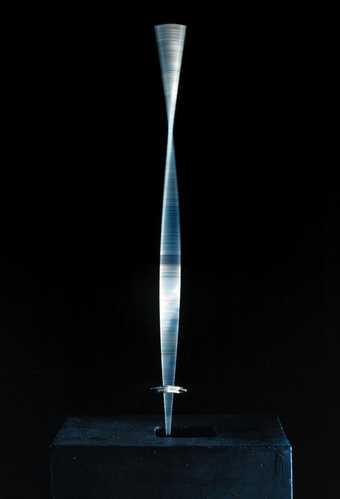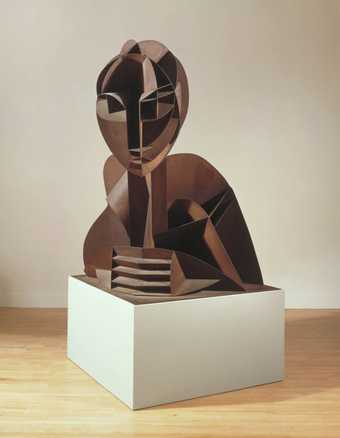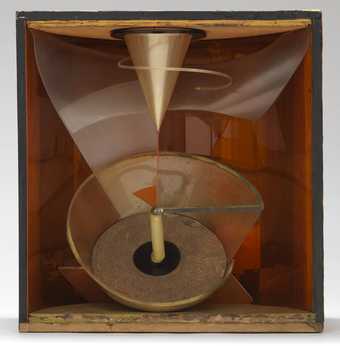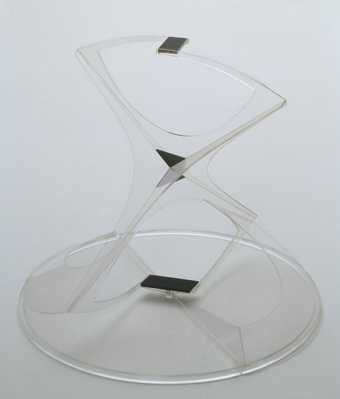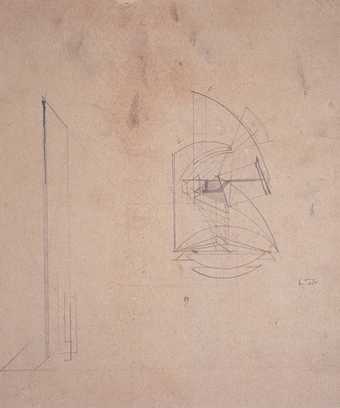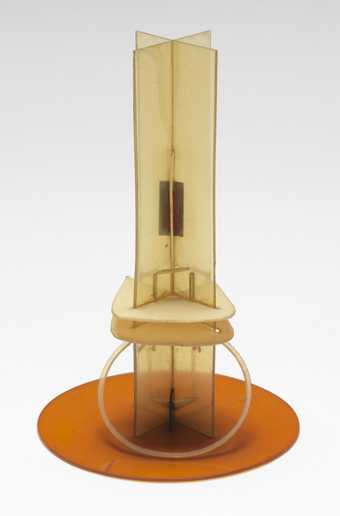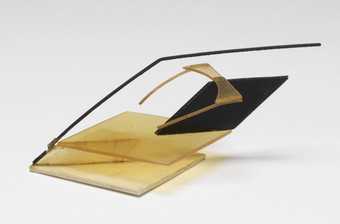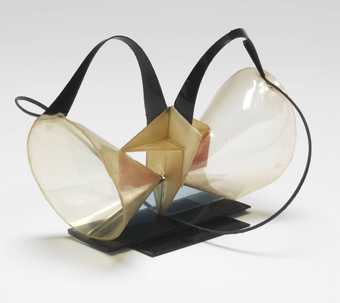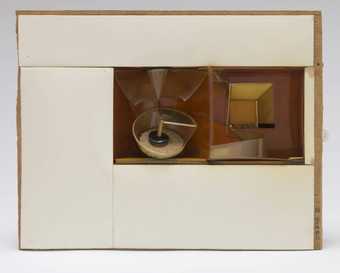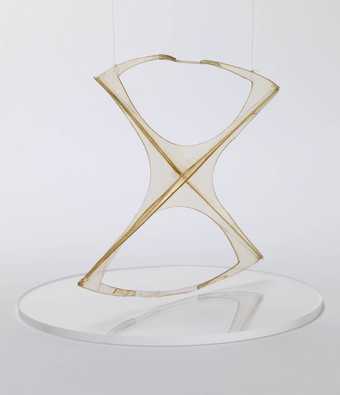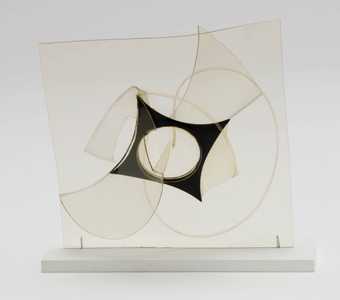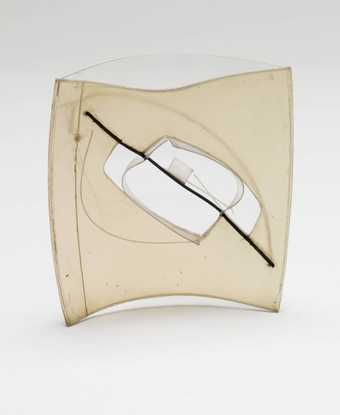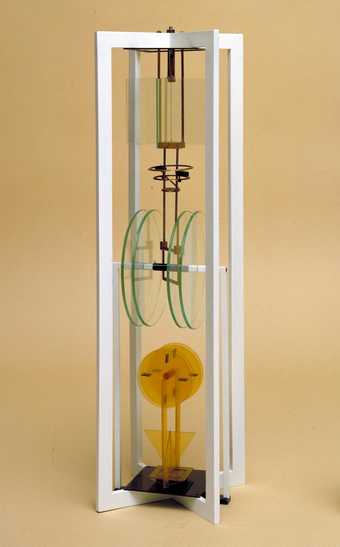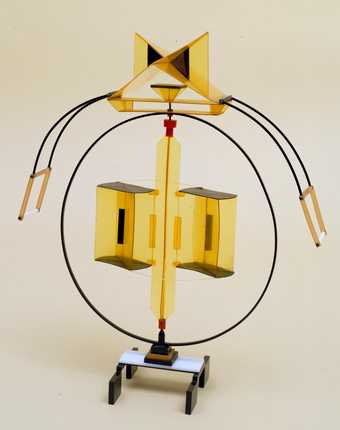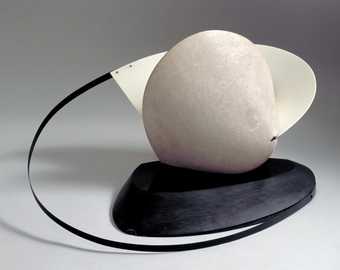
Not on display
- Artist
- Naum Gabo 1890–1977
- Medium
- Cardboard
- Dimensions
- Object: 395 × 290 × 160 mm
- Collection
- Tate
- Acquisition
- Accepted by HM Government in lieu of tax and allocated to the Tate Gallery 1995
- Reference
- T06972
Summary
Model for 'Constructed Torso' is one of the key experimental constructions that launched Naum Gabo's career as a sculptor. It was conceived and probably started in Norway, where Gabo was taking refuge from his native Russia during the First World War. It was completed after his return to Russia at the end of 1917, in the midst of the Revolution. Renouncing traditional sculptural notions of volume and mass, Gabo developed a new working method in this period to express what he saw as the more authentic realities of depth and space. He neither modelled nor sculpted but constructed his works by sticking or welding together small elements, in this case pieces of cut cardboard. In the figure's torso, he suggested volume through intersecting planes to express the dynamics of the sculpture's internal spaces.
Gabo described his technique as 'stereometric', a term which he appropriated from Russian and German mathematical discourse. His fascination with scientific theory and practice was aroused in Munich where, between 1910 and 1913, he studied engineering and medicine alongside art history. Comparing the scientist's methods with those of the artist, he described in his 1920 Realistic Manifesto, co-signed by his brother, the sculptor Antoine Pevsner (1886-1962), how 'we construct our work as the engineer constructs his bridges, as the mathematician his formula of the orbits' (reprinted in Naum Gabo: Sixty Years of Constructivism, exhibition catalogue, Tate Gallery, London 1987, p.9). Model for 'Constructed Torso' echoes the cantilevered form of many modern constructions, its open latticed architecture reminiscent of the great engineering marvel of the late nineteenth century, the Eiffel Tower.
A series of drawings from 1915-16 suggest that this work was conceived initially as a complete standing figure (see Nash and Merkert nos.77-81, pp.156-9). Its subsequent adjustment and evolution is typical of Gabo's working process. Experimenting with sheets of paper or cardboard, he developed small models such as this one, repeatedly refining them until in their final form they became templates for larger versions of the work which were then produced in more durable materials. This work appears to have been the first in a series on the torso theme. It pre-dates another, very similar, cardboard work, Maquette for 'Constructed Torso' 1917-18, reassembled 1985 (see Nash and Merkert no.7, p.97). This maquette was almost certainly the prototype for a version in sheet metal of similar size, bought by the Russian State in 1920 but now lost (reproduced Hammer and Lodder, no.12, p.34). Another version in celluloid, probably constructed in Berlin in the 1920s, also disappeared after it was sold to an American collector in the 1920s.
The torsos followed directly on from another series of works, the heads of 1915-16 (see, for example, Head No. 2 1916, enlarged version 1964, Tate T01520). Where the heads had been relatively static and clearly dissected, the torsos were complex, dynamic figures, displaying Gabo's more confident use of the stereometric method. Model for 'Constructed Torso' consists of three interlocking structural sections: a base component built up around two vertical planes intersecting along a central axis, a waist which acts as a bridging section, and an upper body constructed around a steeply-angled diagonal axis. The fragmented surfaces point to the influence of cubism, with its challenge to the notion of a single viewpoint and its fractured conception of reality. Yet while such sculptors as Jacques Lipchitz (1891-1973), Henri Laurens (1885-1954) and Alexander Archipenko (1887-1964) had eagerly translated these ideas into three dimensions, Gabo's response to cubism was ambivalent. 'The immediate source from which the Constructive idea derives is Cubism,' he said, 'although it had almost the character of a repulsion rather than an attraction' ('The Constructive Idea in Art', in J. L. Martin, Ben Nicholson and N. Gabo (eds.), Circle: International Survey of Constructive Art, London 1937, p.3). Seeing cubism as an iconoclastic experiment which violently attacked the formal unity of the world, Gabo believed that it lacked the natural rhythms and unifying power which were the necessary basis of art. In conceiving the head and torso works, for example, the natural forms of the Norwegian landscape provided a source of inspiration for Gabo. 'I immersed myself in the fathomless expanse of my spatial constructions and visions,' he said; 'I lived in this new world of the silence and brightness of the fjords' (quoted in Hammer and Lodder, p.32).
Model for 'Constructed Torso' was shown at Gabo's first exhibition in France, at the Galerie Percier, Paris, in 1924. Presumed lost, it was discovered in 1977, stored in pieces in Gabo's studio. Following the original glue marks, the model was reconstructed in 1981 by Charles Wilson, Gabo's assistant from 1962 to 1977, and two missing pieces were replaced with new card. The constructive method, first fully realised in the series of heads and torsos, was to remain central to Gabo's conception of sculpture for the next fifty years.
Further Reading:
Martin Hammer and Christina Lodder, Constructing Modernity: The Art and Career of Naum Gabo, New Haven and London 2000, pp.31-52
Steven A. Nash and Jörn Merkert (eds.), Naum Gabo: Sixty Years of Constructivism, Munich 1985, reproduced p.75 in colour
Sean Rainbird, Naum Gabo: In Space and Time, exhibition catalogue, Tate St Ives, Cornwall 2002, reproduced p.4 in colour
Jacky Klein
August 2002
Does this text contain inaccurate information or language that you feel we should improve or change? We would like to hear from you.
Display caption
Gabo's construction of a three-dimensional figure is achieved through intersecting planes without the structure having great mass: rather like load-bearing metal 'H' beams which carry great weight but themselves have little bulk. Gabo's adoption of the stereometric system, in which volume is indicated through being bisected rather than surrounded, is thus structural and descriptive. The relatively unarticulated neck and chest areas of Gabo's earliest constructed heads were radically addressed in the subsequent constructed heads and torsos and 'Model for Constructed Torso' marks the attempt to articulate most of the figure in stereometric planes, and in a cubist idiom.
Gallery label, August 2004
Does this text contain inaccurate information or language that you feel we should improve or change? We would like to hear from you.
Explore
- abstraction(8,615)
-
- from recognisable sources(3,634)
-
- figure(2,270)
- non-representational(6,161)
-
- geometric(3,072)
- formal qualities(12,454)
-
- cubist space(86)
- actions: postures and motions(9,111)
-
- standing(3,106)
- figure(6,809)
You might like
-
Naum Gabo Kinetic Construction (Standing Wave)
1919–20, replica 1985 -
Naum Gabo Head No. 2
1916, enlarged version 1964 -
Naum Gabo Construction in a Niche
1930 -
Naum Gabo Torsion
1928–36 -
Naum Gabo Sketch for a Mobile Construction
c.1918 -
Naum Gabo Model for ‘Column’
1920–1 -
Naum Gabo Model for Monument for an Airport
c.1932 -
Naum Gabo Model for ‘Construction in Space ‘Two Cones’’
1927 -
Naum Gabo Model for ‘Double Relief in a Niche’
1929–30 -
Naum Gabo Model for ‘Torsion’
c.1928 -
Naum Gabo Model for ‘Construction Through a Plane’
c.1935–7 -
Naum Gabo Model for ‘Construction on a Line’
c.1937 -
Naum Gabo Construction in Space: Diagonal
1921–5, reassembled 1986 -
Naum Gabo Model for ‘Rotating Fountain’
1925, reassembled 1986 -
Naum Gabo Construction: Stone with a Collar
1933, this version c.1936–7

